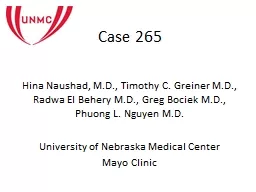

Hina Naushad MD Timothy C Greiner MD Radwa El Behery MD Greg Bociek MD Phuong L Nguyen MD University of Nebraska Medical Center Mayo Clinic History 24yearold ID: 600267
Download Presentation The PPT/PDF document "Case 265" is the property of its rightful owner. Permission is granted to download and print the materials on this web site for personal, non-commercial use only, and to display it on your personal computer provided you do not modify the materials and that you retain all copyright notices contained in the materials. By downloading content from our website, you accept the terms of this agreement.
Slide1
Case 265
Hina Naushad, M.D., Timothy C. Greiner M.D., Radwa El Behery M.D., Greg Bociek M.D., Phuong L. Nguyen M.D. University of Nebraska Medical CenterMayo ClinicSlide2
History
24-year-old male who developed drenching night sweats and bilateral neck fullness Lymphadenopathy and splenomegaly on physical examSlide3
CD34Slide4
TDT
CD1a
CD99
Ki-67Slide5
CD3
CD4
CD7
CD8Slide6
Immunophenotype 2010 LN
PositiveCD3, CD7, CD4, CD43, CD45, BCL2, CD1a, CD99, TdTNegativeCD8, CD20, CD30, CD34, CD117, BCL6, MPOSlide7
Staging Bone Marrow 2010
CBCWBC 10.7, HGB 11.9, PLT 234 Differential countneutrophils 55%, lymphs 17%, monos 13%, eosinophils 13%, basophils 1%. Slide8
CD3Slide9
Marrow (3) - Wright
Giemsa
- Peripheral bloodSlide10
Immunophenotype 2010 Marrow
Flow CytometryNo immunophenotypic abnormalitiesNo lymphoblastsIHCCD3 and CD20 scattered small T and B cellsSlide11
Initial Local Dx and Therapy
LN Bx: T-Lymphoblastic lymphomaBM Bx: Myeloid HyperplasiaHe received 6 cycles of Hyper-CVAD chemotherapy and had maintenance therapy with methotrexate and 6-MP A tyrosine kinase inhibitor was not usedSlide12
Follow up - 2012
Lymphadenopathy recurredT-Lymphoblastic lymphoma again identified in the lymph nodesMyeloid hyperplasia with eosinophils again seen in the restaging marrowSeparate components in LN and marrow just like in 2010Slide13
FISH and Mutation Analysis
Bone Marrow Neg: BCR-ABL, FGFR1, PDGFRB, ETV6, Neg: KIT mutationPositive: CH1C2 deletion by FISH in 2012 BM (Mayo)We returned to the 2010 lymph node biopsy and FISHed it for CHIC2 deletion: PositiveHe was treated with a “Vanderbilt regimen” and underwent an allotransplant in 2013Slide14
Heterozygous deletion of one allele (red/yellow signal lost)Slide15
Interesting Features
This patient developed both a lymphoid and myeloid neoplasm associated with eosinophiliaThe CHIC2 deletion indicates a FIP1L1/PDGRFA fusion transcript as described in the 2008 WHO classification The
lymphoblastic lymphoma and the myeloid neoplasm
occurred completely separately and recurred separately Slide16
Panel Request for Discussion
Spectrum of clinical/pathologic characteristics of myeloid/lymphoid neoplasms with PDGFRA-FIPIL1 What is a possible mechanism for eosinophilia in this case?Slide17
Spectrum of
Disease With a FIP1L1/PDGRFA RearrangementAcute myeloid leukemiaChronic eosinophilic leukemiaLymphoblastic lymphoma/leukemia: T or BSlide18
Spectrum of Disease:
Previous Case Reports of Simultaneous Lymphoid and Myeloid Neoplasms Case 1Case 2Case 3Case 4Age58 M
45 M
33 M
42M
LAD
Yes
Yes
Yes
Yes
Spleen
Yes
Yes
Yes
LN
DxT-LBL N,E,T-LBL N,ET-LBLT-LBLCD4 or CD8CD4CD4CD4CD4 CD8BM DxAML-eosinEosin MPDCEL
Eosin MPNT-LBLT-LBL---*Later B-LBL
1&2 : Metzgeroth G, et al. Leukemia 2007
3: Capovilla M, et al. European J Haematol 2007
4: Huang et al. Leukemia 2012Slide19
Panel Request for Discussion
Spectrum of clinical/pathologic characteristics of myeloid/lymphoid neoplasms with PDGFRA/FIPIL1 What is a possible mechanism for eosinophilia in this case?Slide20
What is the mechanism of eosinophilia?
PDGFRA encodes for the receptor tyrosine kinase, platelet-derived growth factor receptor ABreakpoints occur in the juxtamembrane domain“The 4q12 deletion removes negative regulatory motifs encoded 5’ to the exon 12 breakpoint leading to constitutive activation of this receptor”Slide21
What is the mechanism of eosinophilia? (Continued)
The activated fusion protein is capable of promoting eosinophil-lineage commitment in hematopoietic progenitor cells “in vitro”
Stover et al, PNAS 2006
Fukushima, J Biol Chem 2009
Montgomery et al., Archives of Path 2013Slide22
Proposed Diagnosis
Myeloid and lymphoid neoplasm with PDGFRA rearrangement
Consensus Diagnosis
Myeloid and lymphoid neoplasm with PDGFRA rearrangement, presenting with T-lymphoblastic lymphoma and
myeloproliferative
neoplasm with eosinophilia